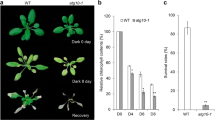Abstract
Intact plants and isolated leaves of Zostera capricornii Martens ex Aschers were transferred from daylight to darkness. Substantial amounts of chloropyll a and b continued to accumulate in immature and mature tissue in the same ratio as in the light and were incorporated into chlorophyll-protein complexes in the thylakoids. A small amount of protochlorophyllide also accumulated in immature tissue in the dark. Proplastids and immature chloroplasts continued to develop into mature chloroplasts in the dark in the normal manner but prolamellar bodies, which are a conspicuous feature of immature chloroplasts, took longer to disperse than in the light. Protochlorophyllide accumulation and prolamellar-body formation were not correlated. The results indicate that Zostera has a genetic capacity for dark chlorophyll synthesis which is expressed in immature and mature leaf tissue and enables this plant to continue synthesising chlorophyll and assembling chloroplasts at night.
Similar content being viewed by others
Abbreviations
- Chl:
-
chlorophyll
- T o :
-
time of transfer to darkness
References
Adamson, H. (1982a) Evidence for a light-independent protochlorophyllide reductase in green barley leaves. In: Progress in clinical and biological research, vol. 102B: Cell function and differentiation, pp. 33–41, Akoyunoglou, G., Evangelopoulos, A.E., Georgatsos, J., Palaiologos, G., Trakatellis, A., Tsiganos, C.P., eds. Alan R. Liss, New York
Adamson, H. (1982b) Chloroplast development in green barley leaves transfered to darkness. In: Progress in clinical and biological research, vol. 102B: Cell function and differentiation, pp. 189–199, Akoyunoglou, G., Evangelopoulos, A.E., Georgatsos, J., Palaiologos, G., Trakatellis, A., Tsiganos, C.P., eds. Alan R. Liss, New York
Adamson, H., Hiller, R.G. (1981) Chlorophyll synthesis in the dark in angiosperms. Proc. Vth Int. Congr. on Photosynthesis, vol. 5: Chloroplast development, pp. 213–221, Akoyunoglou, G., ed. Balaban Services, Philadelphia, Pa., USA
Adamson, H., Hiller, R.G., Vesk, M. (1980) Chloroplast development and the synthesis of chlorophyll a and b and chlorophyll-protein complexes I and II in the dark in Tradescantia albiflora (Kunth). Planta 150, 269–274
Adamson, H., Packer, N. (1984) Dark synthesis of chlorophyll in vivo and dark reduction of protochlorophyllide in vitro by pea chloroplasts. In: Protochlorophyllide reduction and greening, pp. 353–363, Sironval, C., Brouers, M., eds. Martinus Nijhoff/Dr. W. Junk, The Hague
Anderson, J.M., Boardman, N.K. (1964) Studies on the greening of dark-grown bean plants. II Development of photochemical activity. Aust. J. Biol. Sci. 17, 93–101
Anderson, J.M., Waldron, J.C., Thorne, S.W. (1978) Chlorophyll-protein complexes of spinach and barley thylakoids. FEBS Lett. 92, 227–233
Apel, K., Motzkus, M., Dehesh, K. (1984) The biosynthesis of chlorophyll in greening barley (Hordeum vulgare). Is there a light-independent protochlorophyllide reductase? Planta 161, 550–554
Arnon, D.I. (1949) Copper enzymes in isolated chloroplasts. Polyphenoloxidase in Beta vulgaris. Plant Physiol. 24, 1–15
Brouers, M., Michel-Wolwertz, M. (1983) Estimation of protochlorophyll(ide) contents in plant extracts; re-evaluation of the molar absortption coefficient of protochlorophyll(ide). Photosynth. Res. 4, 265–270
Castelfranco, P.A., Beale, S.I. (1983) Chlorophyll biosynthesis: recent advances and areas of current interest. Annu. Rev. Plant Physiol. 34, 241–278
Dennison, W.C., Alberte, R.S. (1982) Photosynthetic responses of Zostera marina L. (eelgrass) to in situ manipulations of light intensity. Oecologia 55, 137–144
Genge, S., Pilger, D., Hiller, R.G. (1974) the relationship between chlorophyll b and pigment-protein complex II. Biochim. Biophys. Acta 347, 22–30
Godnev, T.N., Shlyk, A.A., Rotfarb, R.M. (1959) The synthesis of chlorophyll in the dark in angiosperms. Faziol. Rast. 6, 33–37
Grant, B.R., Wright, S.W. (1980) Purity of chloroplasts prepared from the siphonous green alga, Caulerpa simpliuscula, as determined by their ultrastructure and enzymic content. Plant Physiol. 66, 130–138
Hiller, R.G., Pilger, T.B.G., Genge, S. (1977) Effect of lincomycin on the chlorophyll-protein complex I content and photosystem I activity of greening leaves. Biochim. Biophys. Acta 460, 431–444
Ikegami, I., Kamiya, A., Hase, E. (1984) Dark formation of chlorophyll in cultured tobacco cells. Plant Cell Physiol. 25, 343–348
Kirk, J.T.O., Tilney-Bassett, R.A.E. (1978) The plastids. Elsevier, North Holland Biomediacal Press, Amsterdam New York Oxford
Maitra, P., Mukherji, S. (1983) Dark conversion of protochlorophyllide to chlorophyllide following brief illumination and temperature dependence of photo-induced carotenoid synthesis in rice (Oryza sativa L.) seedlings. Biochem. Physiol. Pflanzen 178, 207–211
Michel-Wolwertz, M.R., Bronchart, R. (1974) Formation of prolamellar bodies without correlative accumulation of protochlorophyllide in pine cotyledons. Plant Sci. Lett. 2, 45–54
Packer, N., Adamson, H., Gregory, J. (1984) Chloroplast development and associated changes in protochlorophyllide and chlorophyll levels in seagrasses transferred to darkness. In: Advances in photosynthesis research, vol. 4: pp. 745–748, Sybesma, C., ed. Martinus Nijhoff/Dr. W. Junk, The Hague Boston Lancaster
Popov, K., Dilova, S. (1969) On the dark synthesis and stabilisation of chlorophyll. In: Progress in photosynthesis research, vol. 2, pp. 606–609, Metzner, H., ed. Int. Union Biol. Sci., Tübingen, FRG
Soloff, B.L. (1973) Buffered potassium permanganate-uranyl acetate-lead citrate staining sequence for ultrathin sections. Stain Technol. 48, 159–165
Spurr, A.R. (1969) A low viscosity Epoxy resin embedding medium for electron microscopy. J. Ultrastruct. Res. 26, 31–43
Treffry, T. (1970) Phytylation of chlorophyllide and prolamellar body transformation in etiolated peas. Planta 91, 279–284
Author information
Authors and Affiliations
Rights and permissions
About this article
Cite this article
Adamson, H., Packer, N. & Gregory, J. Chloroplast development and the synthesis of chlorophyll and protochlorophyllide in Zostera transferred to darkness. Planta 165, 469–476 (1985). https://doi.org/10.1007/BF00398091
Received:
Accepted:
Issue Date:
DOI: https://doi.org/10.1007/BF00398091




